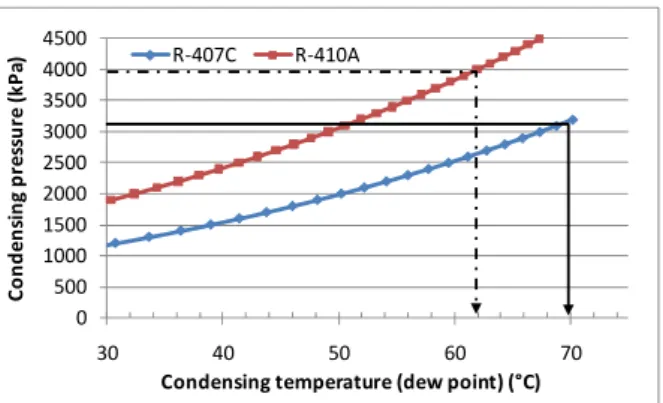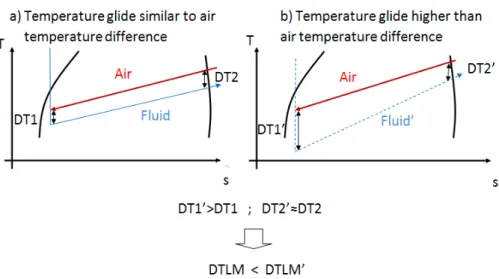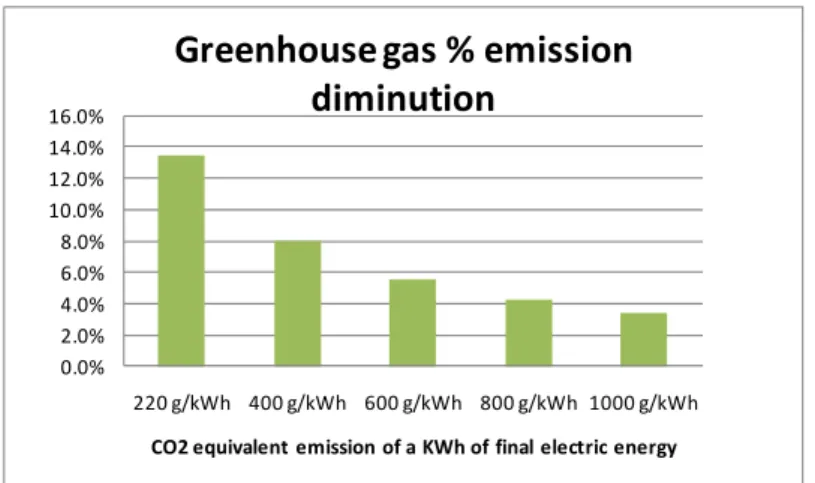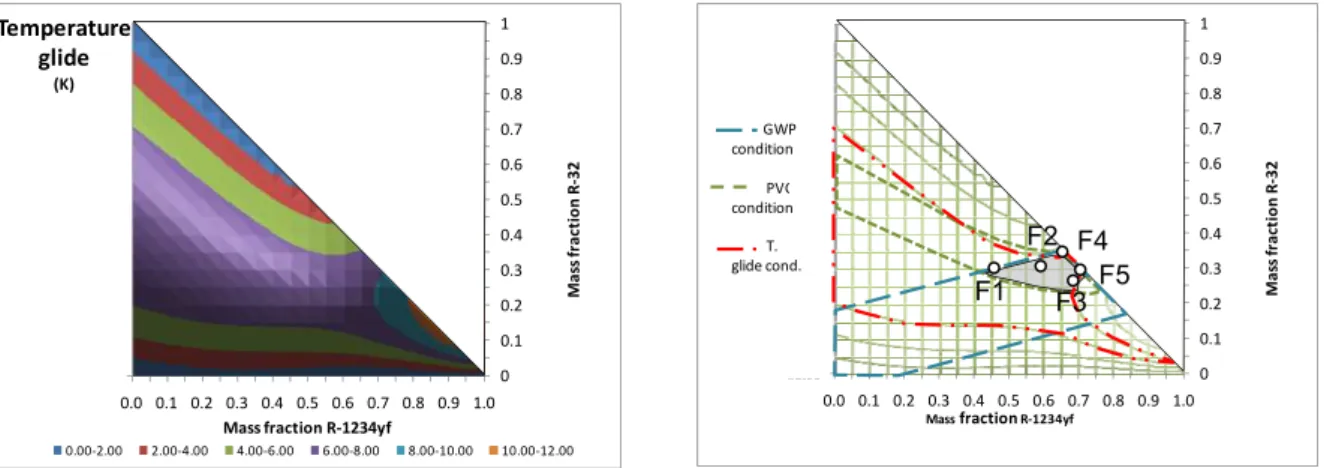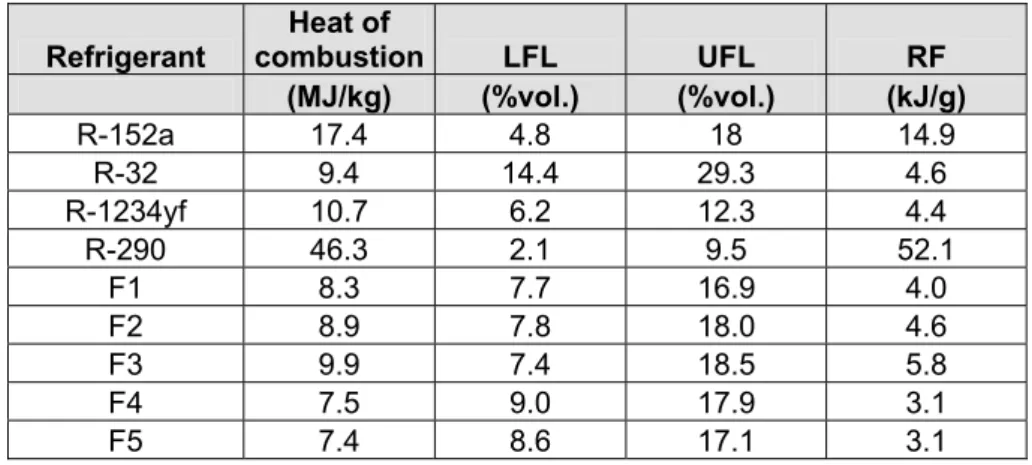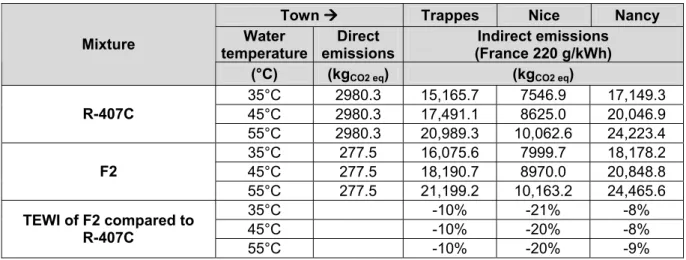HAL Id: hal-00770032
https://hal-mines-paristech.archives-ouvertes.fr/hal-00770032
Submitted on 7 Jan 2013HAL is a multi-disciplinary open access archive for the deposit and dissemination of sci-entific research documents, whether they are pub-lished or not. The documents may come from teaching and research institutions in France or abroad, or from public or private research centers.
L’archive ouverte pluridisciplinaire HAL, est destinée au dépôt et à la diffusion de documents scientifiques de niveau recherche, publiés ou non, émanant des établissements d’enseignement et de recherche français ou étrangers, des laboratoires publics ou privés.
heat pumps
Marcello Bentivegni, Denis Clodic
To cite this version:
Marcello Bentivegni, Denis Clodic. R-1234yf Mixtures for replacing R-407C in residential heat pumps. 10th International Energy Agency Heat Pump Conference 2011 - HPC 2011, May 2011, Tokyo, Japan. 10 p. �hal-00770032�
10thIEA Heat Pump Conference 2011, 16 - 19 May 2011, Tokyo, Japan
R-1234yf MIXTURES FOR REPLACING R-407C IN RESIDENTIAL
HEAT PUMPS
Marcello BENTIVEGNI1, Denis CLODIC2
1,2Center for Energy and Processes, MINES ParisTech,
5, Rue Leon Blum - 91120 Palaiseau, France
1Phone: +33-1-69194513, Fax : +33-1-69194509
Email adress: marcello.bentivegni@mines-paristech.fr
2Phone: +33-1-69194502, Fax : +33-1-69194509
Email adress: denis.clodic@mines-paristech.fr
Abstract: This paper deals with the design of air-to-water heat pumps dedicated to the replacement of old oil boilers. Based on the future building regulation to be issued in France in 2012 for old building refurbishment, the allocation for heating, cooling, lighting, ventilation, and hot water will be of 80 kWh/m2.yr. One of the concerns of the current heat pump technology using either R-407C or R-410A is the high global warming potential of those refrigerant blends. The research project presented in this paper aims at defining new refrigerant blends capable to replace R-407C in those air-to-water heat pumps. The refrigerant blends, which have been modeled and tested, have GWPs varying between 200 and 600 kg CO2 kg-1. Several refrigerants have been simulated using REFPROP 8. One has
been selected and tested on an air-to-water heat pump developed at the laboratory. Energy performances of this blend are similar to those of R-407C.
Key Words: heat pumps, refrigerant blend, TEWI, GWP
1 INTRODUCTION
France represents the second European market for domestic heating heat pumps with 65,500 units sold in 2009. Between these 58,000 are air-to-water systems because traditionally in France heating is delivered on hydronic system. R-410A and R-407C are the typical refrigerants used in those air-to-water heat pumps. R-410A is a near azeotropic blend with a GWP of 2088 kg CO2 kg-1 (IPCC Forth Assessment) and a critical temperature of 69°C,
R-407C is a zeotropic blend with a GWP of 1774 kg CO2 kg-1 and a critical temperature of
85°C. R-410A exhibits higher condensation pressures, so usually the delivered water temperature is limited to 55°C in order to have a condensing pressure lower than 4000 kPa; for R-407C (usually with condensing pressure lower than 3100 kPa), the water temperature can reach 65°C (Figure 1). Systems working with R-407C are often chosen for home heating refurbishment when replacing old boilers.
0 500 1000 1500 2000 2500 3000 3500 4000 4500 30 40 50 60 70 C o n d e n si n g p re ss u re (k P a ) Condensing temperature (dew point) (°C) R 407C R 410A
Figure 1: Condensing temperatures and pressures of R-410A and R-407C
10thIEA Heat Pump Conference 2011, 16 - 19 May 2011, Tokyo, Japan
The evaluation of refrigerants for stationary and mobile refrigeration systems has been done continuously as of 1990 in line with the replacement of CFCs and then HCFCS due to the Montreal Protocol enforcement. The replacement of ozone depleting refrigerants has been successfully accomplished in 10 years but, most of HFCs are high global warming (HGWG) gases (HGWG) and so a new generation of refrigerants is necessary.
Intensive research work has been carried out on refrigerant substitution in order to replace usual HGW refrigerants with new refrigerants presenting lower GWP and similar energy efficiency. Rahhal (2006) proposed new blends based on commercialized HFC refrigerants; Han (2007) proposed a new blend to replace R-407C. Other alternatives are based on the use of carbon dioxide R-744 (Stene, 2005), R-290 (propane), R-1270 (propylene), and blends with hydrocarbons and HFCs (Park, 2006). Each of those alternatives suffers some limitation and implies a limited market. Transcritical CO 2 is adapted to water heaters as
demonstrated by the Eco-cute program but, not for a general use for air-to-air reversible heat pumps. The high flammability of propane and propylene represents a strong constraint for domestic use. The charge limitation and the necessary high quality of the installation are limiting the deployment of air-to-air conditioning systems using HCs. Currently the choice is enlarged by the development of unsaturated HFCs as R-1234yf and others. Fujitaka et al. (2010) and Hara et al. (2010) have already proposed binary azeotropic blends (R-1234yf and R-32) to replace R-410A.
2 REFRIGERANT CHOICE CRITERIA
The criteria for new refrigerants capable to replace HGW HFCs can be summarized by four parameters:
• temperature glide (for blends) • volumetric capacity
• GWP • flammability
The temperature glide has a strong impact on heat exchanger design in order to limit the exergy losses due to the heat exchange with greater differences of temperature between the refrigerant and air or liquids. Pure refrigerants or azeotropic blends have no temperature glide when pressure losses are negligible but, especially in air-to-refrigerant fin-and-tube heat exchangers, the pressure losses generate a temperature glide where the temperature at the inlet is higher than the temperature at the outlet, which generates a lower efficiency of the heat exchange and a higher compressor work. For zeotropic blends such as R-407C, when pressure losses are negligible, the temperature glide is in the other sense for the evaporator: the temperature at the inlet is lower by 3 to 5 K than the temperature at the outlet. In air-to-water HP application, the temperature difference between inlet and outlet air at the evaporator is in the range of 5 K; it could be more at the condenser (between 5 and 10 K) depending on the design. Figure 2 summarizes the impact of heat-exchanger designs on the overall difference of temperatures. A good design with a refrigerant blend leads to limit the overall difference of temperatures between the refrigerant and air; the temperature evolutions are almost parallel. On the contrary, a weak design leads to an increase of the overall difference of temperatures between the refrigerant and air.
10thIEA Heat Pump Conference 2011, 16 - 19 May 2011, Tokyo, Japan
Figure 2: Temperature variations depending on air-to-air evaporator designs with zeotropic refrigerant blend
The volumetric capacity (VC) is important for the system compactness and for the compressor cost. Lessons learned from the replacement of R-22 shows that for small air-conditioning systems with refrigeration capacity up to 10 to 15 kW, R-410A has permitted to lower the initial costs and so making a new constraint for the future design of refrigerant blends. In drop-in conditions, usually the COP of a refrigerant whose capacity is lower is slightly or significantly higher, but the competition among manufacturers is critical on initial cost. So the VC of the drop-in refrigerant has to be as close as possible to the one of the original refrigerant. When the capacity of an alternative refrigerant is significantly different, all the system must be redesigned. In this work mixtures with 10 % maximal VC difference are selected
The GWP is here considered as low if lower than 200 kg eq.CO2.kg-1. This criterion could be
certainly relaxed at a level of 300. Assessments coming from the climate scientific community are necessary to fix a common perspective on those so-called “Low GWP values” of gases emitted in the atmosphere, depending on their lifetime and the emitted quantities. The reference refrigerant is R-407C so its GWP has to be divided by 8.
The reference heat pump considered here has a 8-kW heating capacity at -15°C air temperature with a refrigerant charge of about 3 kg of R-407C. Direct emissions are considered of 2% per year and a loss of 30% of the refrigerant charge at the equipment end of life, fixed at 15 years. The heating needs are that typical of a 100-m2 house in the mild Atlantic climate of France (Trappes). The HP seasonal performance is considered at 3, which means an electric consumption of 5300 kWh for the heating season. For a country like France, with an electric production that generates greenhouse gas emissions of 220 gCO2 for
each electric kWh produced during the heating season, the replacement of R-407C with a refrigerant GWP of 200 kg eq.CO2.kg-1 means a diminution of 13% of total emissions (Figure 3).
Low-GWP refrigerants constitute an advantage for countries with low-carbon dioxide emission electricity.
10thIEA Heat Pump Conference 2011, 16 - 19 May 2011, Tokyo, Japan 0.0% 2.0% 4.0% 6.0% 8.0% 10.0% 12.0% 14.0% 16.0% 220 g/kWh 400 g/kWh 600 g/kWh 800 g/kWh 1000 g/kWh CO2 equivalent emission of a KWh of final electric energy
Greenhouse gas % emission
diminution
Figure 3: Estimation of greenhouse gas reduction for an HP electric consumption of 5300 kWh with different electric productions
For residential heating HP, the flammability has to be as low as possible. R-410A and R-407C are non flammable mixtures but, for the future, low-flammable refrigerants could also be accepted (A2L in ASHRAE and ISO 817 classifications). The major problem for the choice of a drop-in refrigerant is the incompatibility between the last two criteria. Generally a flammable refrigerant has unsaturated chemical bonds, which also means an atmospheric shorter lifetime (more reactivity with OH radicals) and consequently lower GWP.
A large combination of possible mixtures with R-1234yf exists, but if properties of the mixtures are desired close to that of R-407C, then the choice is reduced to R-32 and R-152a.
Figures 4, 5, and 6 show the variations of the first three properties of R-1234yf, R-32, and R-152a blends; for each point in the figure, the R-152a mass fraction is the complement of R-1234yf and R-32 mass fractions. These evaluations have been done with “Refprop 8”.
0 0.1 0.2 0.3 0.4 0.5 0.6 0.7 0.8 0.9 1 0 100 200 300 400 500 600 0.0 0.1 0.2 0.3 0.4 0.5 0.6 0.7 0.8 0.9 1.0 Mass fraction R 1234yf GWP (kg CO2eq.xkg 1) 0 100 100 200 200 300 300 400 400 500 500 600 Ma ss fr a c ti o n R 3 2 0 0.1 0.2 0.3 0.4 0.5 0.6 0.7 0.8 0.9 1 0.10 0.30 0.50 0.70 0.90 1.10 1.30 1.50 1.70 1.90 2.10 0.0 0.1 0.2 0.3 0.4 0.5 0.6 0.7 0.8 0.9 1.0 Mass fraction R 1234yf PVC (kW xm 3 xh) 0.10 0.30 0.30 0.50 0.50 0.70 0.70 0.90 0.90 1.10 1.10 1.30 1.30 1.50 1.50 1.70 1.70 1.90 1.90 2.10 Ma ss fr a ct io n R 3 2
Figure 4: GWP variation of R-1234yf, R-32, and R-152a blends (Refprop 8)
Figure 5: VC variation of R-1234yf, R-32, and R-152a blends (Refprop 8)
VC
(kW x m 3 x h)
10thIEA Heat Pump Conference 2011, 16 - 19 May 2011, Tokyo, Japan 0 0.1 0.2 0.3 0.4 0.5 0.6 0.7 0.8 0.9 1 0.00 2.00 4.00 6.00 8.00 10.00 12.00 0.0 0.1 0.2 0.3 0.4 0.5 0.6 0.7 0.8 0.9 1.0 Mass fraction R 1234yf Temperature glide (K) 0.00 2.00 2.00 4.00 4.00 6.00 6.00 8.00 8.00 10.00 10.00 12.00 Ma ss fr a c ti o n R 3 2 0 0.1 0.2 0.3 0.4 0.5 0.6 0.7 0.8 0.9 1 0.00 2.00 4.00 6.00 8.00 10.00 12.00 0.0 0.1 0.2 0.3 0.4 0.5 0.6 0.7 0.8 0.9 1.0
Mass fractionR 1234yf
Ma ss fr a ct io n R 3 2 GWP condition PVC condition T. glide cond.
Figure 6: Temperature glide variation at 0°C of R-1234yf, R-32, and R-152a blends (Refprop 8)
Figure 7: Evaluation of possible blends based on GWP, VC, and temperature glide criteria
In Figure 7, the grey surface represents the zone where mixtures respect the three conditions. In this , five refrigerants have been chosen: F1, F3, F4, and F5; slight variation in refrigerant concentrations can lay to large differences in mixture characteristics F4 and F5 are binary mixtures of R-1234yf and R-32; this segment is very short (5% variation of refrigerant mass concentration allowed). The most versatile refrigerant blends are F3 and F5 because they are near a temperature glide variation peak; slight concentration variation increased the temperature glide up to 12 K. F2 is in the center of the grey surface and has so be chosen as an interesting compromise making possible small variations of the refrigerant mass concentrations.
Compared to R-407C, F2 blend has a temperature glide 1-K higher, a VC 5% higher, a critical temperature of 91°C (Table 1). COPs calculated with 45°C temperature at the refrigerant condenser inlet and 0°C at the evaporator outlet are very close.
Table 1: Thermodynamic data for R-407C and R-1234yf mixtures at 0°C
Refriger ant % mass R-1234yf % mass R-32 % mass R-152a Pressure glide Temp. glide GWP Critical temp. VC COP th (0°C/45°C) (kPa) (K) (kgCO2 kg-1) (°C) (kW m-3 h) R-407C 107 6.3 1774 86.0 1.14 4.82 F1 0.65 0.25 0.10 133 7.5 152 90.8 1.15 4.78 F2 0.55 0.30 0.15 120 6.6 185 91.2 1.20 4.80 F3 0.45 0.30 0.25 118 6.9 197 93.7 1.14 4.84 F4 0.65 0.35 0.00 140 7.9 195 90.3 1.15 4.77 F5 0.70 0.30 0.00 151 7.7 168 86.7 1.24 4.67
The flammability has been evaluated calculating the RF-number (Kondo, 2002) as in Equation (1):
(1)
where HC is the heat of combustion, M the molar mass, LFL the lower flammability limit, and
UFL the upper flammability limit.
F1 F2
F3 F4
F5
10thIEA Heat Pump Conference 2011, 16 - 19 May 2011, Tokyo, Japan
The heat of combustion of blends has been calculated by balancing the chemical equations as in Takizawa (2005); the upper and lower flammability limits have been estimated as in Zhao (2004).
The five blends have RF-numbers very close to those of R-32 and R-1234yf, which are ranked in A2L (low flammable) ASHRAE safety group (Table 2).
Table 2 : Flammability data for R-32, R-152a, propane, R-1234yf, and his mixtures
Refrigerant Heat of combustion LFL UFL RF (MJ/kg) (%vol.) (%vol.) (kJ/g) R-152a 17.4 4.8 18 14.9 R-32 9.4 14.4 29.3 4.6 R-1234yf 10.7 6.2 12.3 4.4 R-290 46.3 2.1 9.5 52.1 F1 8.3 7.7 16.9 4.0 F2 8.9 7.8 18.0 4.6 F3 9.9 7.4 18.5 5.8 F4 7.5 9.0 17.9 3.1 F5 7.4 8.6 17.1 3.1 3 TEST DESCRIPTION
Measurements have been performed on an air-to-water heat pump with a 7.4-m3 per hour volumetric flow compressor (Figure 8). The hot water has been controlled with a precision of ± 1 K by a heater and a cooler in series. The air has been controlled in a climatic chamber with an electric heater of ±0.5 K precision. An electronic expansion valve has been chosen in order to control 5-K superheat at the evaporator outlet using “Refprop 8” for both refrigerants.
The energy consumptions of the compressor, the water pump, and fans have been measured by a wattmeter. The heat capacity at the condenser has been measured on the waterside by a flow meter and PT100 sensors. The water flow has been adjusted to obtain 5 K ±0.5 difference of temperature between the condenser inlet and outlet. Each measure has been held stable for 20 minutes before being accepted.
Tests have been performed with different charges of R-407C and F2 blend.
3.1. Refrigerant charge optimization
The evaluation of the optimum refrigerant charge shows the best COP values for 2.8-kg refrigerant charge of R-407C (Figure 9). The overcharge of the system has little influence on the performance. For F2 mixture, best results have been measured at 2.5-kg refrigerant charge (Figure 10); for this blend performances are more sensible at overcharge.
Figure 8: Air-to-water heat pump with measure apparatus, water, and air
temperature regulation
10thIEA Heat Pump Conference 2011, 16 - 19 May 2011, Tokyo, Japan 2 2.5 3 3.5 4 25 35 45 55 65 C O P Water temperature (°C) 2 kg 2.5 kg 2.8 kg 3.2 kg 2 2.5 3 3.5 4 25 35 45 55 65 C O P Water temperature (°C) 2kg 2.5 kg 2.7 kg 2.95 kg 3.3 kg
Figure 9: COP for different refrigerant charges of R-407C and water temperatures
Figure 10: COP for different refrigerant charges of R-1234yf, F2 mixture, and water
temperatures
3.2. Comparison of R-407C and F2 blend
The two refrigerants have been compared at 7°C of air temperature and different water temperatures. For the heat pump components, Figure11 shows that:
• the compression rate is 3 to 6% lower for F2 compared to R-407C
• at low pressure, R-407C is more efficient; its DTLM at the evaporator is smaller than the one of F2 blend,
• at high pressure, F2 blend is more efficient, so the DTLM is lower for F2, which means more efficient heat exchange at the condenser.
The compressor outlet temperatures of mixtures are very close (Figure12); the F2 temperature is 2 to 4 K higher than that of R-407C.
60.00% 40.00% 20.00% 0.00% 20.00% 40.00% 35 40 45 50 55 Water temperature (°C) Compression rate DTLM evap DTLM cd 0 10 20 30 40 50 60 70 80 90 35 40 45 50 55 (° C ) Water temperature (°C) Compressor outlet temperature F2 R 407C
Figure 11: Difference in performance of F2 compared to R-407C in compressor,
evaporator, and condenser
Figure 12: Compressor outlet temperatures for F2 and R-407C 8.00% 6.00% 4.00% 2.00% 0.00% 2.00% 4.00% 35 40 45 50 55 Water temperature (°C)
Heating capacity Electric consumption COP
Figure 13: Energetic efficiency of F2 compared to R-407C
10thIEA Heat Pump Conference 2011, 16 - 19 May 2011, Tokyo, Japan
The F2 energy efficiency is very close to that of R-407C (Figure 13). The heating capacity is in general lower for F2 but, the difference is low at high water temperature. That underlines again that F2 is more efficient at high condensation temperatures. Electric consumption is 2% higher for F2 in average. The final COP for F2 is lower by 1 to 6%; that difference between the two refrigerants decreases as the compression rate increases.
For TEWI, we take as reference the retrofit of an R-407C heat pump in the French cities of Trappes (mild Atlantic), Nice (Mediterean climate), and Nancy (mild Continental) with typical heating needs of a 100-m2 house. As stated before, for direct emissions we consider a 2% annual refrigerant leak and a loss of 30% of total refrigerant mass at the HP end of life. Heating needs and the seasonal COP for different water temperatures are shown in Table 3. Seasonal COPs are calculated on the basis of a commercial R-407C heat pump information note and considering external air temperature occurrence for the three towns.
Table 3: Heating needs, average winter temperatures, and seasonal COPs for different French cities
Town Trappes Nice Nancy
Yearly heating needs (kWh) 15,901 8,233 17,617
Average winter temperature (°C) 7 10 5.7
S. COP @ 35°C water temperature 3.46 3.6 3.39
S. COP @ 45°C water temperature 3 3.15 2.9
S. COP @ 55°C water temperature 2.5 2.7 2.4
The carbon dioxide emission values are calculated on 15-year time horizon. Final carbon dioxide emissions are lower of 10% for Trappes, 20% for Nice, and 8 % for Nancy (Table 4). The emission reduction is partially lowered by higher indirect emissions (6 to 1%). Direct emissions of F2 are ten times lower than that of R-407C; that diminution has a significant impact in cities with low heat needs.
10thIEA Heat Pump Conference 2011, 16 - 19 May 2011, Tokyo, Japan
Table 4: Carbon dioxide equivalent emissions for F2 and R-407C on 15-year time horizon
Town å Trappes Nice Nancy
Water temperature Direct emissions Indirect emissions (France 220 g/kWh) Mixture (°C) (kgCO2 eq) (kgCO2 eq) 35°C 2980.3 15,165.7 7546.9 17,149.3 45°C 2980.3 17,491.1 8625.0 20,046.9 R-407C 55°C 2980.3 20,989.3 10,062.6 24,223.4 35°C 277.5 16,075.6 7999.7 18,178.2 45°C 277.5 18,190.7 8970.0 20,848.8 F2 55°C 277.5 21,199.2 10,163.2 24,465.6 35°C -10% -21% -8% 45°C -10% -20% -8% TEWI of F2 compared to R-407C 55°C -10% -20% -9% 4 CONCLUSION
A ternary mixture of R-1234yf, R-32, and R-152a (55%, 30%,15% mass fraction) with low GWP has been chosen using “Refprop 8” in order to replace R-407C in existing air-to-water heat pump installations. The flammability has been estimated with RF-number. The mixture has been tested and compared to the reference refrigerant. Results show that F2 mixture presents energy performances close to that of R-407C. The final outcome on total carbon dioxide emissions is a reduction of 8 to 20% for a residential heating heat pump installed in French cities.
NOMENCLATURE
CFC Chlorofluorocarbon
DT Temperature difference K
DTLM Logarithmic Mean Temperature Difference K
GWP Global Warming Potential kgCO2 eq kg-1
VC Volumetric capacity kW m-3 h
HC Heat of combustion MJ kg-1
LFL Lower Flammability Limit %
M Molar Mass Kg mol-1
ODP Ozone Depletion Potential
RF RF number kJ g-1
TEWI Total Emission Value kgCO2 eq
UFL Upper Flammability Limit %
10thIEA Heat Pump Conference 2011, 16 - 19 May 2011, Tokyo, Japan REFERENCES
Fujitaka A. et al. 2010. “Application of Low Global Warming Potential Refrigerants for Room Air Conditioners”, 2010 International Symposium on Next Generation air Conditioning and
Refrigerant Technology, 17-19 February, Tokyo, Japan.
Hara H., Oono M., Iwata I. 2010. “Experimental Study of Low GWP Refrigerants for Room Air Conditioners”, 2010 International Symposium on Next Generation air Conditioning and
Refrigerant Technology, 17-19 February, Tokyo, Japan.
Han X.N, et al. 2007. “Cycle performance study on R32/R125/R161 as an alternative refrigerant to R-407C”,Applied Thermal Engineering, 27, pp. 2559–2565.
Kondo S., Takahaski A., Tokuhashi K., Sekiya A. 2002. “RF-number as a new index for assessing combustion hazard of flammable gases”, Journal of Hazardous Materials, A93, pp. 259-267.
NIST. 2007. “Refprop 8”, Standard Reference Database 23 Version 8.0
Park K., Jung D. 2006. “Thermodynamic performance of HCFC-22 alternative refrigerants for residential air-conditioning applications”, Energy and Buildings, 3, pp. 675–680.
Rahal C., Clodic D. 2006. “Method of choice of low TEWI refrigerant blends”, International
Refrigeration and Air Conditioning Conference at Purdue University, July 17-20.
Stene J. 2005. “Residential CO2 heat pump system for combined space heating and hot
water heating”,International Journal of Refrigeration, 28, pp; 1259–1265.
Takizawa K., et al. 2005. “Burning Velocity Measurement Of Fluorinated Compounds by spherical-vessel method”, Combustion and Flame, Vol.141, pp. 298-307.
Zhao Y., Bin L., Haibo Z. 2004. “Experimental study of the inert effect of 134a and R-227ea on flammability limit of the flammable refrigerants”, Experimental Thermal and
refrigerant Science, 28, pp. 557-563.
